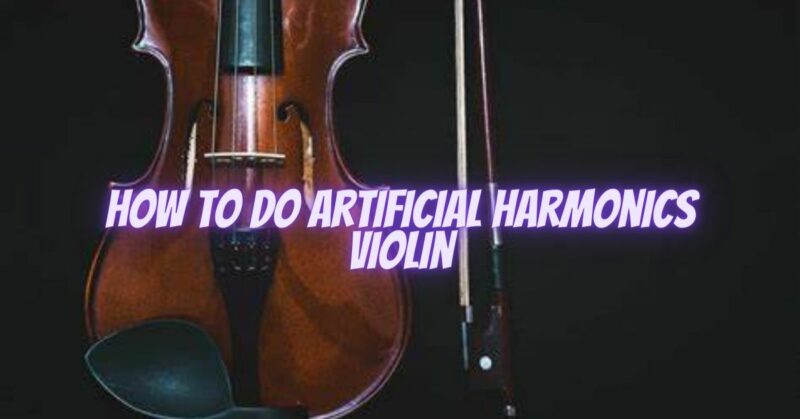Artificial harmonics, also known as false harmonics or fingered harmonics, are a technique used by violinists to produce harmonics on pitches that are not part of the natural harmonic series. This technique expands the range of expressive possibilities on the violin, allowing for ethereal and shimmering sounds. In this article, we will explore the step-by-step process of producing artificial harmonics on the violin and provide practice tips to help you master this captivating technique.
Step 1: Understand the Basics of Harmonics: Before delving into artificial harmonics, it is essential to have a solid understanding of natural harmonics produced on the violin. Familiarize yourself with the natural harmonic series and practice producing harmonics on open strings. This foundation will help you grasp the concept of harmonic nodes and the relationship between finger placement and pitch.
Step 2: Find the Harmonic Node: To produce an artificial harmonic, you need to locate the harmonic node, which is the point on the string where the desired harmonic is found. The node divides the string into two segments: the vibrating segment (between the bridge and the finger) and the stationary segment (beyond the finger). Experiment by lightly touching the string with your finger while playing a note to find the harmonic node.
Step 3: Finger Placement: Place your left-hand finger on the string to stop the desired pitch. This finger acts as the “node creator,” dividing the string into the vibrating and stationary segments. The finger placement determines the harmonic that will be produced. The most common artificial harmonics are produced by placing the first finger (index finger) one octave above the stopped pitch.
Step 4: Maintain Light Finger Pressure: Apply light and precise pressure with your left-hand finger to create the node. The pressure should be just enough to touch the string, allowing the natural harmonic to sound. Pressing too hard can dampen the harmonic and produce an unwanted muffled sound.
Step 5: Play the Harmonic: With your left-hand finger creating the node, use your right-hand bow to draw the bow across the string, maintaining a consistent and controlled bowing motion. The bow should contact the string at a point that corresponds to the harmonic node created by your left hand. Experiment with the bowing angle and pressure to find the optimal sound.
Step 6: Refine Intonation and Technique: Artificial harmonics require precision in finger placement and intonation. Use a tuner to ensure accuracy in pitch and gradually refine your technique. Practice slowly and methodically, gradually increasing speed and fluency. Pay attention to the clarity, purity, and balance of the harmonics produced.
Practice Tips:
- Begin with Simple Exercises: Start by practicing simple exercises that involve playing artificial harmonics on one string at a time. Gradually expand to multiple strings and melodic passages as your proficiency increases.
- Isolate Left-Hand Finger Placement: Isolate the left-hand finger placement and practice finding the harmonic nodes without the bow. Focus on accuracy and consistency before incorporating the bowing technique.
- Experiment with Bowing Techniques: Vary the bowing techniques, such as bow speed, pressure, and contact point, to achieve different tonal qualities and effects with the artificial harmonics. Explore soft and delicate sounds, as well as bold and dynamic expressions.
- Listen and Adjust: Develop a keen ear for intonation and tonal balance. Listen carefully to the harmonics produced and make adjustments to your finger placement, bowing, and left-hand pressure as needed.
- Integrate into Musical Repertoire: Incorporate artificial harmonics into your repertoire, including solo pieces, orchestral excerpts, or chamber music. Practice integrating them seamlessly within musical phrases, paying attentionto musical expression and the overall context of the music.
- Seek Guidance: Consider working with a violin teacher or mentor experienced in artificial harmonics. They can provide guidance, offer personalized feedback, and suggest specific exercises and repertoire to help you develop your skills.
Conclusion: Mastering artificial harmonics on the violin opens up a world of expressive possibilities. By understanding the fundamentals of natural harmonics, finding the harmonic nodes, refining finger placement and pressure, and practicing with precision and musicality, you can produce beautiful and ethereal sounds on your instrument. Remember to be patient and persistent in your practice, and gradually integrate artificial harmonics into your musical repertoire. With time, dedication, and attention to detail, you can unlock the enchanting world of artificial harmonics on the violin.


